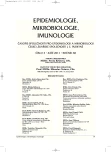Prevention of Tick-Borne Meningoencephalitis – Summary Report
Authors:
J. Vlčková 1
; V. Rupeš 2; H. Kollárová 1; D. Horáková 1
Authors‘ workplace:
Ústav preventivního lékařství, LF UP v Olomouci
1; Konzultant pro ochrannou dezinsekci a deratizaci
2
Published in:
Epidemiol. Mikrobiol. Imunol. 60, 2011, č. 3, s. 109-114
Overview
Tick-borne meningoencephalitis is a zoonosis that shows an upward trend. The causative agent is an RNA virus of the family Flaviviridae whose vector in Central Europe is the castor bean tick (Ixodes ricinus). The infection is most often transmitted via tick bite or, less commonly, by the alimentary route, through the consumption of unpasteurized milk of infected animals. Preventive measures consist in personal protection from ticks, exceptionally in blanket treatment with contact insecticides, in preventing consumption of unpasteurized milk and dairy products from areas with a high incidence of tick-borne encephalitis, and particularly in vaccination of the susceptible population.
Key words:
castor-bean ticks – Ixodes ricinus – tick-borne encephalitis – vaccination
Sources
1. Beneš, J. et al. Infekční lékařství. 1. vyd. Praha: Galén, 2009, s. 651.
2. Beran, J., Havlík, J., Vonka, V. Očkování minulost, přítomnost, budoucnost. 1. vyd. Praha: Galén, 2005, s. 348.
3. Cisak, E., Wójcik-Fatla, A., Zajac, V., Sroka, J., Buczek, A., Dutkiewicz, J. Prevalence of tick-borne encephalitis virus (TBEV) in samples of raw milk taken randomly from cows, goats and sheep in eastern Poland. An. Agric. Envirion. Med., 2010, 17, p. 283–286.
4. Daniel, M., Danielová, V., Kříž, B., Jirsa, A., Nožička, J. Shift of the tick Ixodes ricinus and tick-borne encefalitis to higher altitudes in Central Europe. Eur. J. Clin. Microbiol. Infect. Dis., 2003, 22. p. 327–328.
5. Ditzen, M., Pellegrino, M., Vosshall, L. B. Insect odorant receptors are molecular targets of the insect repellent DEET. Science, 2008, Vol. 319, No. 5871, p. 1838–1842.
6. Ginsberg, H. S., Faulde, M. K. Ticks: 303-321. In Bonnefoy, X., Kampen, H., Sweeney, K. Public health signifikance of urban pests. WHO Europe, 2008, p. 569.
7. Heinz, F. X,, unz, C. Tick-borne encephalitis and the impact of vaccination. Arch. Virol., Suppl. 004, 18, p. 201–205.
8. Chmelík, V. Klíšťová meningoencefalitida. Pediatrie pro praxi, 2009, 5, p. 306–310.
9. Kříž, B., Beneš, Č., Danielová, V., Daniel, M. Socio--economic conditions and other anthropogenic factors influencing tick-borne encefalitis incidence in the Czech Republic. Int. J. Med. Microbiol., 2004, 293, Supl. 37, p. 63–68.
10. Kříž, B., Beneš, C., Daniel, M. Alimentary Transmission of Tick-borne Encephalitis in the Czech Republic (1997–2008). Epidemiol. Microbiol. Imunol., 2009, 58, p. 98–103.
11. Perret, J. L., Rais, O., Gern, L. Influence of climate on the proportion of Ixodes ricinus nymphs and adults questing in a tick population. J. Med. Entomol., 2004, 3, p. 361–365.
12. Rupeš, V., Chmela, J., Ledvinka, J., Balůsek, J. Efficacy of some contact insecticides on the tick Ixodes ricinus. International Pest Control, 1980, 6, p. 144–150.
13. Volf, P., Horák, P. et al. Paraziti a jejich biologie. Praha: Triton, 2007, s. 241.
14. http://www.szu.cz/tema/prevence/klistova-encefalitida-1
Labels
Hygiene and epidemiology Medical virology Clinical microbiologyArticle was published in
Epidemiology, Microbiology, Immunology

2011 Issue 3
Most read in this issue
- The Use of IgG Antibody Avidity Assays in the Diagnosis of Cytomegalovirus Infection
- Amoebae of the Genus Acanthamoeba – Causative Agents of Human Infections
- Vaccination against Viral Hepatitis A and B in Adults Aged over 40 Years – Antibody Persistence and Immune Memory
- Prevention of Tick-Borne Meningoencephalitis – Summary Report
